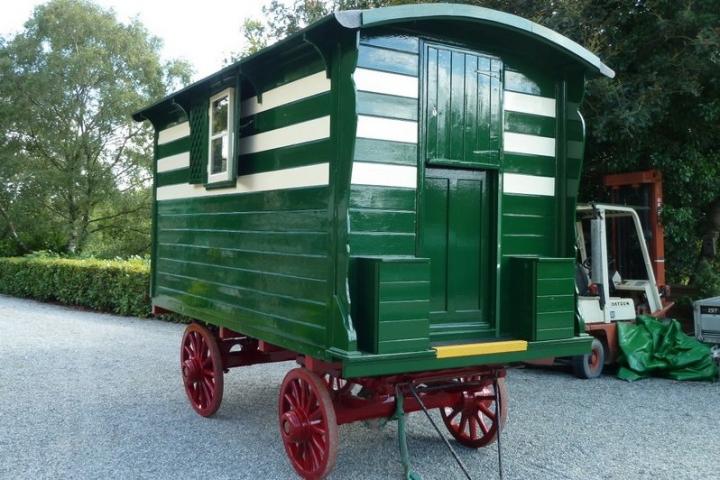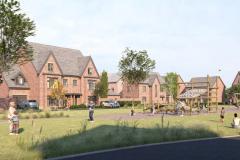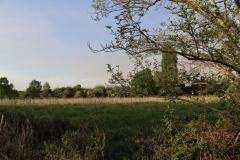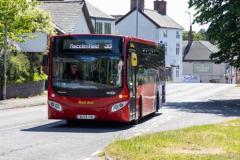
In the interests of clarification, fairness, and to avoid misunderstanding, I am posting this statement, which makes clear the views of the majority of the Committee members of the Romany Society and the family of the Rev.G.Bramwell Evens- better known as 'Romany of the BBC'.
In recent weeks, a great deal of public debate and comment has taken place, on websites, television interviews and in the Press, regarding the fate of the caravan or vardo, formerly owned by 'Romany' and the Evens family. Donated to the Council of the day by his wife, following his death, it has stood for around seventy years at the Wilmslow site,and has been the focal point of the activities of our Society.
It is unquestionably a unique national treasure, and has been lovingly restored, thanks to the generosity of our membership, however, the decision by it's legal owners, Cheshire East Council, to seek a new permanent home for it has resulted in public debate and frankly a good deal of rhetoric and misrepresentation of the facts.
The position of the majority of the members of the Romany Society Committee is that, given the circumstances in which we find ourselves, and taking into account the best professional advice available to us, we accept that the Wilmslow site poses major problems for the long term survival and safety of the caravan, and that a properly protected, secure site such as a reputable public collection or museum, would be not only preferable but could well assure a greater public exposure and appreciation of the vehicle and 'Romany's' work.
Much is being made of the Council's lack of care for the caravan and their motives for wishing to rehome it. Whether they are purely motivated by a desire to do the best for the caravan, or wish to relinquish an item which is an inconvenience, is debatable and to a large extent irrelevant, since it is a distraction from the real issue; which is how we assure the survival of this priceless and unique vehicle. It has suffered from neglect and the elements over the years, going back to the 1960's, and the recent restoration uncovered some very serious deterioration caused by years of poor maintenance. The fact is that we in the Society do not have legal control of the caravan, and while we can offer advice and opinions, our funding of the restoration has given us no legal influence over it, nor did we ever think that it would. We acted purely to save it from further, inevitable deterioration, without thought of buying the right to dictate it's fate later.
Our view is shared by the family members of Bramwell Evens, represented by his daughter Romany Watt and his grandson, Rev. Roly Bain. They have made it clear that they want to see it preserved in the most appropriate conditions and location, and accept that this may not be at Wilmslow. 'Romany' only lived in Wilmslow for the last four years of his life, and the caravan only came to the town after his death.The traditional attachment to Wilmslow was an accident of history, and is certainly not a good enough reason to condemn the vehicle to the risk of fire, theft and decay. In fact, both 'Romany' and the caravan have far more Yorkshire and Cumbrian connections than Cheshire ones and it should be born in mind that our Society serves members from all over the UK, not simply in Cheshire.
Those Committee members campaigning for the retention of the caravan at the Wilmslow site at all costs, for whatever reason, are in a minority of three, and while they have every right to their viewpoint, they have no right whatsoever to promote this as the view of the majority of Committee members. Any impression given, either deliberately or accidentally, that this is the case, is an inaccurate one, and we would like to publicly make this very clear at this point.
Informed debate is to be encouraged, but much of what appears to be circulating is based on half-truths and distortions of the truth, and in the interests of the reputation of our Society we wish the media and public to be fully aware that, while there are certainly differences of viewpoint within the Committee, we are not equally divided but have expressed a majority view supporting a possible move to a more secure long term home.
The caravan must not become a pawn or tool in a game of public 'Council-bashing'. It is far too important and precious for that, and it is disrespectful to the memory of a great national broadcasting naturalist to treat it as such.
On behalf of the majority of the members of the Romany Society and the Evens family.
This is a member post by John Thorpe, Hon. Secretary of the Romany Society.










Comments
Here's what readers have had to say so far. Why not add your thoughts below.
I do agree that the caravan is a unique national treasure and needs to be appropriately sited and cared for. I agree that the site at the “Romany Memorial Garden” at South Drive in Wilmslow as it current exists, does pose problems for the long term survival and safety of the caravan if it were to return there. However, these problems are in no way insurmountable.
It would be great if all involved could take “a step back” and look at this issue with a set of full and truthful facts. Those who are in the end going to make the decision on the caravans future should do so based on a clear understanding of facts. These should include; Who is the rightful legal owner of the caravan? What is needed to ensure that the caravan is maintained to its current restored state? And what is the most appropriate location for future home and why?
So, in the interest of clarity may I ask you to respond to the following questions.
How many members does the Romany Society have?
How is membership determined? (A subscription fee?)
Has the society balloted all of its members on their views on what should happen to the caravan?
How many committee members are there?
What was the result of the ballot of the committee members? (How many in favour? How many against?)
Which organisation paid for the transportation of the caravan to the restorers?
Which organisation paid for the insurance of the caravan whilst it was being transported to the restorers?
Which organisation is paying for its insurance whilst it is at the restorers?
Are any “storage” chargers now being accrued as the restoration work has been completed?
If so who is paying for the storage chargers?
Which organisation will be responsible for the cost of transporting the caravan to its new/old home?
Can the committee of the Romany Society provide a definitive response as to how and why the caravan appears to be owned by Cheshire East Council?
I look forward to a response to enable all parties to “stand back” and look at this subject again with a fully informed and truthful set of facts.
Thank you for taking the trouble to respond to my statement, and I will of course be delighted to respond to your questions, as I will to any others seeking clarification about this matter.
My only concern in all this, is to ensure that people are fully aware of the complexity of the situation, and the fact that this iconic vehicle is not used as a pawn in petty politics or personal vendettas.
The answers to your questions, in order of asking, are as follows:
1. At the present time approx. 220, but as people renew or new members join, this can reach up to 300 on occasion.
2. Membership is decided by a subscription fee on application to the Membership Secretary.
3. The Society has already balloted members on the possible siting of the caravan, through our newsletter. A small number responded and most were either in favour of a move or not against it if circumstances demanded.
However, at our last Committee meeting it was agreed to repeat the exercise in a forthcoming newsletter, to ensure that people, in the light of current circumstances, were given another opportunity to express their views. Since they paid for the restoration, it is only right that they have a chance to express their views, but it must be realised, that, in reality, the Council are under no legal obligation to abide by them, for they have to act on all the information available to them, and members may or may not fully appreciate the complexity of the situation.
4. There are currently seven Society Committee members.
5. There are four members for a move or not against a move, and three who feel that the caravan must return to Wilmslow.
6. The Society paid the costs of removal to the restorers.
7. The Society paid the cost of insurance cover while at the restorers.
8.The restorers are not making any charges for storage at the present time, and have given no indication that they wish to do so.
9. An interesting question. We have been told that the Council (Cheshire East) will fund the costs of transportation.
10. The chain of ownership runs as follows, to the best of my knowledge:
The Rev.G.Bramwell Evens-‘Romany of the BBC’
Mrs.Eunice Evens.
Wilmslow Urban District Council.
Macclesfield Borough Council.
Cheshire East Council.
It is always possible that another Council body between the Urban District Council and Macclesfield Borough Council may have had ownership, but since I am not a local resident and am not an expert in the succession of Councils in the area, I cannot categorically say that the list is complete. Mrs.Evens handed over the caravan to the Romany Memorial Committee of Wilmslow Urban District Council on October 7th 1944, and confirmed this by letter on January 4th 1945 .
I trust that this answers your questions and will be happy to be of assistance in future.
Sincerely,
John Thorpe-Hon.Secretary.
The Romany Society.
Thank you. This is really helpful
Stuart
Wilmslow has very little heritage to promote, other than location of smallest visitor attraction, with residential provenance & Blue Plaque for Alan Turing.
CEC used the caravan as Santa's Grotto for 2 yrs. How does thus equate to Romany;s ideals?
A wood & metal construction, kept outdoors for 75+ yrs is likely to deteriorate faster if brought indoors without further conservancy.
Google Mary Rose.
Mr.Cash’.s brief comments regarding the likely deterioration of the vardo if kept indoors, and his ‘Mary Rose’ references warrant a response, based on fact, not on rhetoric or personal opinion.
Let us consider the case of the ‘Mary Rose’,which most people will know was the pride and joy of Henry VIII, and which sank unexpectedly hundreds of years ago. Like most, if not all warships of the time, she was constructed of oak in large part.Oak is strong and resilient to rot and actually preserves well in conditions which would destroy other woods.The fact that the remains of the ship must be kept constantly misted with water of the appropriate salinity and chemical composition to prevent drying out and splitting, proves only one thing,that even the hardest wood does not fare well when exposed to extremes of heat and varying moisture.
Wooden caravans are not made of oak.The spokes of the wheels are usually of oak for strength,but the body is composed of various types of wood,selected for their individual strengths and properties. A wooden caravan,like any other wooden structure,is at the mercy of the elements while outside,and the old caravans,used by Romanies, were just as vulnerable to this damage as are more modern versions. The difference was that they were often constantly on the move,never staying in one place for too long,so that the sun and other elements did not have time to seriously affect them from one direction and with intensity.
In addition,‘Sun Sheets’, made of calico cloth, were used to shield the paintwork from the sun,and these can be clearly seen in many historic photographs from the 19th and early 20th centuries. Romany’s caravan has stood for many years on the same spot in the same position, therefore exposing it to the worst of the prevailing wind,rain and sun,and coupled with a lack of proper maintenance,the expected results have occured;as evidenced by the severe damage noted during restoration.This damage has been photographed and documented,and is therefore not a matter of my opinion, but fact.
There is no comparison between the case of the ‘Mary Rose’ and any wooden caravan,and the ‘Cutty Sark’, mentioned by other contributors,is a completely different case,with no relevance whatever to Romany’s caravan.
Perhaps some clarification would prove useful at this point. Renovation,which is what has occured in the case of the ‘Cutty Sark’,can legitimately mean using all new or a significantly large percentage of new materials,and following the disasterous fire which almost totally destroyed the vessel, the renovators have had to use large amounts of modern materials,including marine ply and resins.
Restoration is a completely different thing,and depending upon damage present,means repairing damaged areas with materials appropriate to the original construction while keeping as much of the original material and character in place.Romany’s vardo had been restored,not renovated,and this is clearly stated on all documentation concerning the work by the UK Vardo Project.
With regard to Mr.Cash’s remarks concerning the deterioration of the vardo if kept indoors after so many years out of doors,I can only assume that he has sought expert opinion on this,or is indeed an expert himself;and if so perhaps he would be good enough to share with us publicly what his personal qualifications and experience are,or which experts he has consulted?
The Society’s advice comes directly from the UK Vardo Project in Nth.Wales, acknowledged experts in the field with many years of practical experience of dealing with wooden, horse-drawn vehicles,and well respected by those who know the subject;including Lord Montagu,who has an incredibly significant and rare wooden caravan,indoors,in his world renowned collection.The ‘Wanderer’ belonged to Gordon Stables,the inventor and promoter of leisure caravanning in the late 19th century,and was only saved for posterity by being purchased,restored and kept indoors in properly regulated climatic conditions-it would not be here today for us to see if it had been left out in the elements without protection.
It is absolutely true that some caravans have deteriorated in museum conditions where excessive dry heat,caused by modern heating methods,was present over many years;but where the atmosphere is not excessively hot,and is well ventilated,they survive remarkably well,needing little attention for many years and aging gracefully.
If Mr.Cash wishes to verify this, he need only consult Hartlebury Castle Museum in Worcester,one of the country’s finest and most respected collections of wooden vehicles,where many rare examples,including ‘Esmeralda’;once owned by John Samson the Romany researcher,are kept in immaculate condition-indoors.Interestingly ‘Esmeralda’ was rescued from a garden in Macclesfield, where it was decaying,and was saved in the nick of time.It has not deteriorated indoors,is constantly monitored and protected, and is a perfect example of how the vardo from Wilmslow could be equally well cared for indoors. If Mr.Cash has any actual evidence that the museum in Bradford,for example, would not provide the correct conditions,perhaps he would share it with us?
With regards to the use of the vardo as Santa’s Grotto,the Society had no actual control over this whatsoever,and while we were consulted as a matter of courtesy,we were well aware that it would go ahead even if we objected.In fact many of us had real misgivings about the safety of the vardo from a perspective of fire and damage,and asked for every measure to be taken to protect it. ‘Romany’s empathy with children probably would mean that he would not have had severe objections,but I’m equally sure he would not have approved of the many staples which were used to fix trimmings etc;something we were not aware of until notified by the UK Vardo Project,who found them while sanding the wood down!
In conclusion, perhaps in future articles or comments, Mr.Cash could confine himself to factual information and not speculate about a subject which,judging by recent comments,he seems ill-equipped to pass expert opinion on. Before anyone gets the impression that I or any other Committee member are experts in the field, I should reiterate that we take professional advice into account and try to avoid unnecessary ill-informed speculation.
My purpose in doing this is to to continue my investigations to determine the following.
1 - Why did Mrs Evens hand over the caravan to the Romany Memorial Committee of Wilmslow Urban District Council on October 7th 1944?
2 - Why do Cheshire East Council believe that they are the rightful and legal owner of the caravan?
3 - Why are they the rightful owner?
4 - What is needed to ensure that the caravan is maintained in its current restored state?
5 - Why is this needed?
6 - What is the most appropriate location for its future home?
7 - Why is that location most appropriate?
I look forward to hearing form you.